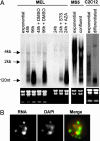Accumulation of small murine minor satellite transcripts leads to impaired centromeric architecture and function
- PMID: 16731634
- PMCID: PMC1482643
- DOI: 10.1073/pnas.0508006103
Accumulation of small murine minor satellite transcripts leads to impaired centromeric architecture and function
Abstract
RNAs have been implicated in the assembly and stabilization of large-scale chromatin structures including centromeric architecture; unidentified RNAs are integral components of human pericentric heterochromatin and are required for localization of the heterochromatin protein HP1 to centromeric regions. Because satellite repeats in centromeric regions are known to be transcribed, we assessed a role for noncoding centromeric RNAs in the structure and function of the centromere. We identified minor satellite transcripts of 120 nt in murine cells that localize to centromeres and accumulate upon stress or differentiation. Forced accumulation of 120-nt transcripts leads to defects in chromosome segregation and sister-chromatid cohesion, changes in hallmark centromeric epigenetic markers, and mislocalization of centromere-associated proteins essential for centromere function. These findings suggest that small centromeric RNAs may represent one of many pathways that regulate heterochromatin assembly in mammals, possibly through tethering of kinetochore- and heterochromatin-associated proteins.
Conflict of interest statement
Conflict of interest statement: No conflicts declared.
Figures



References
-
- Choo K. H. The Centromere. New York: Oxford Univ. Press; 1997.
-
- Vafa O., Sullivan K. F. Curr. Biol. 1997;7:897–900. - PubMed
Publication types
MeSH terms
Substances
LinkOut - more resources
Full Text Sources
Other Literature Sources
Research Materials

